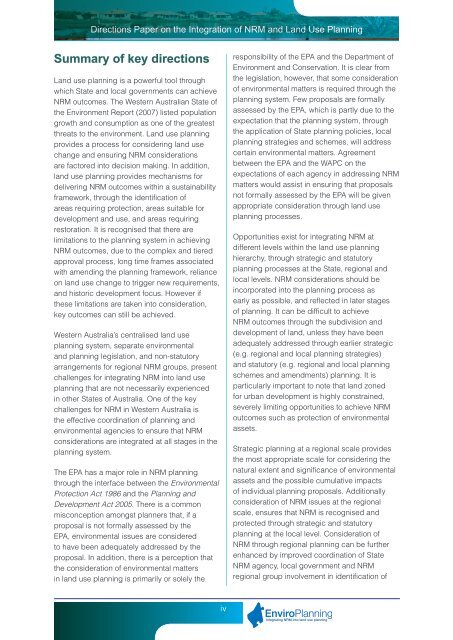Directions Paper - Western Australian Planning Commission
Directions Paper - Western Australian Planning Commission
Directions Paper - Western Australian Planning Commission
You also want an ePaper? Increase the reach of your titles
YUMPU automatically turns print PDFs into web optimized ePapers that Google loves.
<strong>Directions</strong> <strong>Paper</strong> on the Integration of NRM and Land Use <strong>Planning</strong>Summary of key directionsLand use planning is a powerful tool throughwhich State and local governments can achieveNRM outcomes. The <strong>Western</strong> <strong>Australian</strong> State ofthe Environment Report (2007) listed populationgrowth and consumption as one of the greatestthreats to the environment. Land use planningprovides a process for considering land usechange and ensuring NRM considerationsare factored into decision making. In addition,land use planning provides mechanisms fordelivering NRM outcomes within a sustainabilityframework, through the identification ofareas requiring protection, areas suitable fordevelopment and use, and areas requiringrestoration. It is recognised that there arelimitations to the planning system in achievingNRM outcomes, due to the complex and tieredapproval process, long time frames associatedwith amending the planning framework, relianceon land use change to trigger new requirements,and historic development focus. However ifthese limitations are taken into consideration,key outcomes can still be achieved.<strong>Western</strong> Australia’s centralised land useplanning system, separate environmentaland planning legislation, and non-statutoryarrangements for regional NRM groups, presentchallenges for integrating NRM into land useplanning that are not necessarily experiencedin other States of Australia. One of the keychallenges for NRM in <strong>Western</strong> Australia isthe effective coordination of planning andenvironmental agencies to ensure that NRMconsiderations are integrated at all stages in theplanning system.The EPA has a major role in NRM planningthrough the interface between the EnvironmentalProtection Act 1986 and the <strong>Planning</strong> andDevelopment Act 2005. There is a commonmisconception amongst planners that, if aproposal is not formally assessed by theEPA, environmental issues are consideredto have been adequately addressed by theproposal. In addition, there is a perception thatthe consideration of environmental mattersin land use planning is primarily or solely theresponsibility of the EPA and the Department ofEnvironment and Conservation. It is clear fromthe legislation, however, that some considerationof environmental matters is required through theplanning system. Few proposals are formallyassessed by the EPA, which is partly due to theexpectation that the planning system, throughthe application of State planning policies, localplanning strategies and schemes, will addresscertain environmental matters. Agreementbetween the EPA and the WAPC on theexpectations of each agency in addressing NRMmatters would assist in ensuring that proposalsnot formally assessed by the EPA will be givenappropriate consideration through land useplanning processes.Opportunities exist for integrating NRM atdifferent levels within the land use planninghierarchy, through strategic and statutoryplanning processes at the State, regional andlocal levels. NRM considerations should beincorporated into the planning process asearly as possible, and reflected in later stagesof planning. It can be difficult to achieveNRM outcomes through the subdivision anddevelopment of land, unless they have beenadequately addressed through earlier strategic(e.g. regional and local planning strategies)and statutory (e.g. regional and local planningschemes and amendments) planning. It isparticularly important to note that land zonedfor urban development is highly constrained,severely limiting opportunities to achieve NRMoutcomes such as protection of environmentalassets.Strategic planning at a regional scale providesthe most appropriate scale for considering thenatural extent and significance of environmentalassets and the possible cumulative impactsof individual planning proposals. Additionallyconsideration of NRM issues at the regionalscale, ensures that NRM is recognised andprotected through strategic and statutoryplanning at the local level. Consideration ofNRM through regional planning can be furtherenhanced by improved coordination of StateNRM agency, local government and NRMregional group involvement in identification ofiv

















